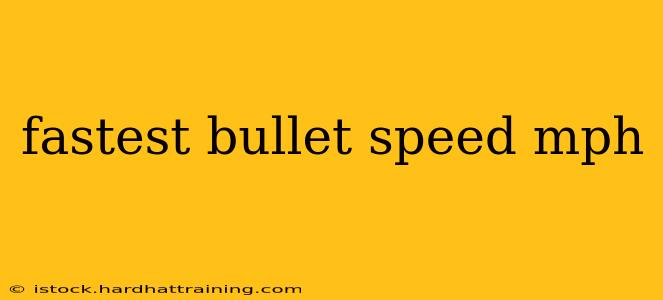The question of the fastest bullet speed is a fascinating one, delving into the world of ballistics and firearm technology. While a definitive answer hinges on specific cartridge designs and environmental factors, we can explore the upper limits of bullet velocity and the factors influencing it. This article will dissect the speeds achieved by various ammunition types, highlighting the science behind these incredible velocities.
Understanding Bullet Speed and its Measurement
Bullet speed, or muzzle velocity, is measured in feet per second (fps) or meters per second (m/s), often converted to miles per hour (mph) for easier comprehension. It's crucial to understand that this speed is recorded at the muzzle – the end of the gun barrel – and decreases rapidly due to air resistance. The initial velocity is the most significant factor determining range and impact energy.
Factors Affecting Bullet Speed
Several factors significantly influence a bullet's speed:
- Caliber: Larger calibers generally don't equate to faster speeds. The cartridge design, powder charge, and barrel length are far more critical.
- Powder Charge: The amount of propellant directly impacts the force driving the bullet down the barrel. A larger charge usually results in higher velocity.
- Barrel Length: A longer barrel allows more time for the expanding gases from the propellant to accelerate the bullet, increasing its velocity.
- Bullet Weight: Heavier bullets generally travel slower than lighter bullets with the same powder charge. This is because the same force is acting on a larger mass.
- Environmental Conditions: Temperature, air pressure, and humidity can slightly affect bullet speed. Higher temperatures and lower air pressure can lead to marginally higher velocities.
High-Velocity Cartridges: Reaching Extreme Speeds
Certain cartridges are renowned for pushing bullets to exceptional speeds. While precise figures vary based on testing conditions and specific ammunition brands, some consistently rank among the fastest:
- .220 Swift: Historically known for its impressive speed, this cartridge has been a favorite among long-range shooters. Many .220 Swift rounds reach velocities exceeding 4,000 fps.
- .17 Remington: This smaller caliber cartridge is designed for varmint hunting and is capable of remarkably high speeds, often exceeding 4,000 fps.
- .22-250 Remington: Another popular choice for long-range shooting and varmint hunting, boasting velocities often exceeding 4,000 fps.
- .204 Ruger: This newer cartridge stands out for its exceptional accuracy and high muzzle velocity, regularly achieving speeds exceeding 4,000 fps.
The Importance of Safety
It's imperative to emphasize that handling high-velocity ammunition requires expertise and strict adherence to safety protocols. Improper handling can lead to severe injury or fatality. Always consult with experienced firearm professionals and strictly follow the manufacturer's guidelines for safe firearm handling and ammunition usage. Never handle firearms or ammunition unless you've received proper training and understand the inherent risks involved.
Conclusion: The Pursuit of Speed and Accuracy
The pursuit of faster bullet speeds has driven innovation in ammunition and firearm design. While the precise "fastest" bullet remains somewhat subjective, the cartridges mentioned above consistently demonstrate exceptional velocity. However, speed is only one aspect of effective ammunition; accuracy, consistency, and terminal ballistics are equally important considerations for hunters and target shooters alike. Always prioritize safety and responsible firearm ownership.
